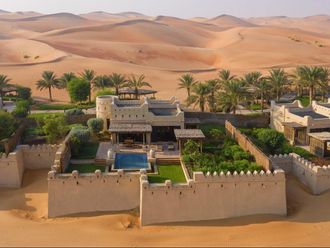
Sharjah: Salem Mohammad Saeed Al Suraidi must be in his nineties.
Though he is not sure about his exact age, the grand old man is certainly sure about one thing he has been known for since his youth — the art of ropemaking.
Al Suraidi, who is from a village near Khor Fakkan, is adept at traditional ropemaking, using date palm fibre. Even after so many years, with failing memory and weakening limbs, he enjoys making ropes.
“I have been doing this since I was a boy and I love making ropes, it’s something I still enjoy doing as it brings back memories from the past when I used to do this for a living and we lived a traditional way of life,” said Al Suraidi, who is among a group of senior citizens who have skilfully recreated the traditional Emirati way of life at Sharjah Heritage Days.
Sharjah Heritage Days is an annual event held at the Heart of Sharjah that celebrates the Emirati heritage by demonstrating the traditional way of life to younger generations. Organised by the Sharjah Institute of Heritage, the 16th edition of the heritage festival brings together all traditional art, crafts and vocations, recreating life of the past.
Open from 4pm to 10pm on weekdays and till 11pm on weekends, the Sharjah Heritage Days will run up to April 21. Rope-making
Rolling the loose date palm fibre between his palms, Al Suraidi can work the whole day, making several metres of rope in a day.
“He enjoys making ropes so much that he can go on for hours uninterrupted, only taking breaks to pray or eat. This is what he has been doing all his life. This is how people survived back then doing different things for a living,” said Rashid Al Abdouli, speaking about Al Suraidi.
Al Abdouli, 44, hails from Al Qurayyah, a village in Fujairah on the East Coast, and is from the last generation of Emiratis who as a youngster saw a glimpse of the traditional way of life.
“Many people worked in the farm, while many others used the produce from farms to make things like making ropes, weaving wicker baskets, making mats and bags as well as thatched roofs, all using different parts of the palm tree,” he said.
“We want to show our younger generation what life was about in those days and the kind of skills that were required to make a living. Life was hard but enjoyable, and people were attached to their land and knew how to make things using materials that were naturally available in their environment,” added Al Abdouli.
Farming
His friend, Ali Al Kaabi, is a farmer and takes care of the palm trees like his children. At the Cultural Heritage Events Centre, where the festival is taking place, Al Kaabi demonstrates the skills of tending to palm trees and how to climb the trees safely using a ring of rope made with palm fibre.
An important part of farming is getting water for the trees. Wells played an important role in irrigating the fields. With no pump sets and electricity, how would you draw water from the wells and supply it to the field?
“Falaj or water channels played an important role in irrigation. Bulls or camels were used to draw water from the wells using a rope and pulley. An open-ended leather bag was tied to one end of the rope, which ran over a pulley and the other end of the rope was tied to the bull, which was made to walk away from the well to draw the water and a person would pour it in the mouth of the falaj,” said Al Kaabi, explaining the traditional irrigation mechanism that is on display at the festival, complete with a real well and a live bull.
Seafaring
Another important aspect of the traditional Emirati life and a key source of livelihood for many was seafaring, which involved both fishing and pearl diving.
And unlike in the modern times, the Emiratis of the past were not depended on imports for the fishing equipment.
“Fishing was an important part of Emirati life and different people were involved in different occupations related to fishing. Right from the boats used for fishing to nets, buoys, hooks, sails and all the equipment required were made locally using only the locally available materials,” said Abdullah Ahmad Al Shehi, as he took us through the demonstration of all activities that made seafaring possible in those days.
Like men, women also played equally important roles such as weaving, knitting, stitching, griding and cooking delicious delicacies.
Some of these mouthwatering homemade delicacies like harees, Maqluba, Samak Harra, Lugaimat, Machboos and others are available for food lovers at the festival, which, along with the games, entertainment and shopping opportunities make the fair a perfect place for a family to enjoy while learning about Emirati heritage.
A total of 31 countries are participating in the festival, which houses a cultural café, a children’s village as well as a Year of Zayed-themed exhibition, among other things.
What’s on
What: Sharjah Heritage Days
Where: Cultural Heritage Events Centre, Sharjah
When: Daily till April 21
Time: 4pm to 10pm — weekdays; 4pm to 11pm — weekends
Entry: Free







